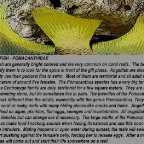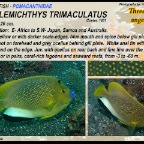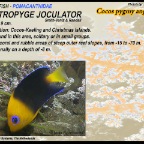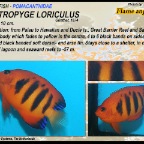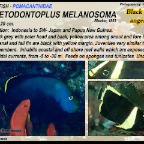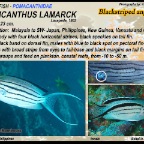ANGELFISH - POMACANTHIDAE These mostly bright colored fish are very known on coral reefs. The best way to identify them is to look for the spine in front of the gill plates. Angelfish are slow, they only use their pectoral fins to swim. Most of them are very territorial and all adult males have a harem from around five females. The species Pomacanthus have very big territory's while the Centropyge family only takes a few square meters as a territory. They are mostly seen swimming solitary but sometimes live in pairs. The juveniles of the Pomacanthidae family look different than the adults, especially with the genus Pomacanthus. They prefer healthy coral or rocky reefs with many hiding places like cracks and holes. Angelfish mainly feed on algae, plankton, fish eggs, sponges and invertebrates. All angelfish are born as females but can change sex if necessary. The large adults of the Pomacanthus family can make loud knocking sounds when feeling threatened and uses this sounds to provoke intruders. Mating happens in open water during sunset, the male will swim up and start pushing against the females belly forcing her to release eggs. After a month the larvae will come out and start their life somewhere on a reef. Length: 45 cm.
Distribution: From the Maldives to Vanuatu, N- Taiwan and Great Barrier Reef.
Bright blue face with yellow mask, blue ocellus on soft dorsal fin.
Shy and not common in most areas. Adults generally solitair, often near caves.
Near coral-rich areas of lagoon and seaward reefs, from 5 to -25 m.
Hybridizes with P. navarchus. Length: 10 cm.
Distribution: From E- Africa to SW- Japan, Micronesia, Fr. Polynesia and E- Australia.
Yellow-red body with narrow blue vertical bars, head, back and fins are blue to purple.
Dorsal, anal and tail fin have a pale blue margin. Pelvic and pectoral fins are yellow-
orange. Two blue spines on lower gill cover. Shy, stays always close to his shelter.
Solitary or in small groups, on outer reefs and lagoons. From -5 to -45 m. Length: 25 cm.
Distribution: From the Red Sea to Tuamotu Is., Ryukyus and New Caledonia.
Very common in coral-rich areas of clear lagoons and seaward reefs, from 1 to 48 m.
Solitair or in pairs, often near caves and crevices. Juveniles secretive, usually in
caves along dropoffs. Length: 46 cm.
Distribution: From Malaysia to Solomon Is., SW- Japan and New Caledonia.
Blue and yellow scales, five dark vertical bands and one white band behind the eyes.
Dark-blue tail fin with light-blue spots which become smaller with age.
On silty as well as clear coral-rich areas of lagoons and seaward reefs down to -50 m.
Sometimes hybridizes with P. xanthometopon. Adult species are territorial. Length: 38 cm.
Distribution: From E- Africa to Fiji, S- Japan and Lord Howe.
Brown greenish body with small blue spots and pale yellow lips. Blue margins on
gillplate and all fins exept the pectoral fins. Juveniles among rocks or coral of shallow
sandy protected reefs to -30 m. Adults in coral-rich areas of coastal reefs, often in
caves or wrecks. Solitary. Length: 50 cm.
Distribution: From the Red Sea to the Arabian Gulf and Zanzibar.
Pale to dark blue, dark blue scales on fore head. Large yellow vertical patch on sides.
Pink to purple shades in dorsal, anal and tail fin. Juvenile stage unknown, not shy.
Around turbid inshore reefs with little coral growth, but occasionally in coral rich
areas down to -25 m. Length: 45 cm.
Distribution: From E- Africa to Solomon Is., Ryukyus and Papua New Guinea.
Dark yellow body with dark blue face and bright blue lining and ocellus next to fore-
head. Yellow pelvic and pectoral fins and white tail fin.
Adults often in pairs among caves or wrecks. Coastal reefs, down to -35 m. Length: 15 cm.
Distribution: SW- Japan to Micronesia, Fr. Polynesia, N- Caledonia and E- Australia.
Males can become 15 cm with blueish head and body, horizontal black and white
stripes on the side. Females are a bit smaller with short black bars above the eyes
and black margins on dorsal, anal and tailfin. In small or large aggregations above
reef slopes, from -12 to -80 m. Length: 10 cm.
Distribution: From Sumatra to Vanuatu, S- Japan and Lord Howe.
Backside of the body black with fine blue margin on the edge of the fins.
Very shy and always close to a shelter. Lives solitair among coral-rich areas of
lagoons and seaward reefs, from 3 to -25 m. Hybridizes with C. flavissimus and
C. eibli. Length: 10 cm.
Distribution: from Palau to Hawaiian and Ducie Is., Great Barrier Reef and Samoa.
Orange body which fades to yellow in the centre, 4 to 6 black bands on sides.
Blue and black banded soft dorsal- and arse fin. Stays close to a shelter, in coral-rich
areas of lagoon and seaward reefs to -57 m. Length: 40 cm.
Distribution: R.Sea & E- Africa, S.W- Japan, Hawaii, Fr. Polynesia, N. Caledonia, Austr.
This common angelfish is very easy to recognise, makes knocking sounds when
disturbed. Juveniles solitary under ledges or in holes, adults generally in coral-rich
areas of deep lagoons and seaward reefs down to -70 m. Haremic, but usually seen
single or in pairs. Feeds on tunicates, sponges and other encrusting organisms. Length: 9 cm.
Distribution: Cocos-Keeling and Christmas Islands.
Only found in this area, solitary or in small groups.
Among coral and rubble areas of steep outer reef slopes, from -15 to -70 m.
Occasionally on a depth of -8 m. Length: 18 cm.
Distribution: Malaysia and Indonesia to SW- Japan, Solomon Is. and N- Australia.
White with dark-brown or black body. Black vertical band over the eyes, yellow snout
with blue lips. Yellow or grey tail fin, White to blue margin on anal- and rear part of
the dorsal fin. Lives solitary or in pairs, on coral-rich inshore reefs to -20 m.
Feeds on sponges, tunicates and filamentous algae.
Length: 19 cm.
Distribution: Malaysian P. to S.W- Japan, New Guinea, Lord Howe Is. and N- Australia.
Dark blue body with black blotch above pectoral fins. White area on sides, becomes
larger with age. Broad yellow margin on anal fin, pelvic fins have yellow centre.
Solitary or in small groups, feeds on algae.
Coral and rubble areas of lagoons and seaward reefs, from -4 to -55 m. Length: 15 cm.
Distribution: Bay of Bengal & Sri Lanka to S- Indonesia and N.W- Australia.
Greyish body color with fine orange vertical bars, black part in anal and dorsal fin.
Black tail with blue margin, yellow-orange chest and ring around the eyes.
Solitary, but often in pairs. Feeds on algae.
Rocky or coral-rich areas of seaward reefs, from -3 to -25 m. Length: 15 cm.
Distribution: from Malaysia to SW- Japan, Samoa, N. Caledonia and N.W.&E- Australia.
Yellow head and front body with blue blotch above eyes, blue rear body, yellow tail fin.
Orange spot above gill plate and on chin. Lives solitary, in pairs or in small groups,
around coral-rich reefs with many shelters. In lagoons and protected seaward reefs,
from -3 to -25 m. Feeds on algae, small crustaceans and worms. Length: 25 cm.
Distribution: From the Caroline- to the Line Islands.
Dark yellow with golden scales, blue lips. Black dorsal, tail and anal fin.
All fins exept the pectoral fin have a blue outline. Black dot on forehead.
Lives solitary or in small groups, in lagoons and on seaward slopes below -3m.
Length: 26 cm.
Distribution: E- Africa to S.W- Japan, Samoa and Australia.
Bright yellow or with darker scale-edges, blue mouth and spine below gill plate.
Black spot on forehead and grey ocellus behind gill plate. White anal fin with broad
black band on the edge. Juv. with ocellus on rear back and fine line over the head.
Solitary or in pairs, coral-rich lagoons and seaward reefs, from -3 to -60 m.
Length: 45 cm.Distribution: Bermuda, Bahamas, S- Florida, Gulf of Mexico and Yucatan.Adults, blue-grey to brownish with yellow margin on dorsal, anal and tail fin.Pale-edged scales on body, yellow pelvic fins. Juveniles, blue-banded. Mid-stage, yellow with pale blue margin on dorsal and anal fin, pale blue-edged blackspot on fore head. Rock or coral reefs, from -2 to -92 m. Feeds on sponges



